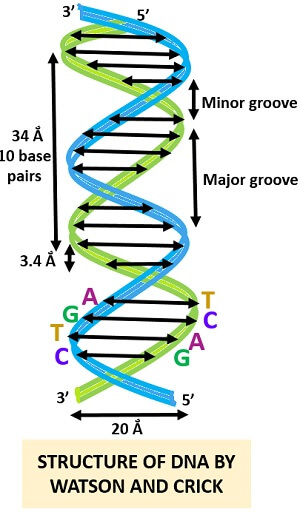
In 1953
They conducted that:
- Polynucleotide chain of DNA has a regular helix,
- Helix has a diameter of about 20 Ao, and
- Helix makes a full turn at every 34 A0 along its length and contains 10 nucleotides per turn, because per internucleotide distance is 3.4 Ao .
- To provide thermodynamic stability they thought over the formation of H-bonds with amino (-NH2) or hydroxyl (-OH) and ketone oxygen or amino-nitrogen of two bases.
- Sequence of bonding is such that for every ATGC on one strand there would be TACG on another.
- 2 chains are Complementary to eachother.
- Sequences of nucleotides on one chains are photocopy of sequences of nucleotides on another.
- 2 strands ran in antiparallel direction i.e., they have opposite polarity.
- Left hand strand has 5’ to 3’ polarity
- Right hand strand has 3’ to 5’ polarity
- Polarity is due to direction of phosphodiester linkage.
- H-bonds between 2 strands are such that they maintain a distance of 20 A0.
- Double helix coils in right hand direction. i.e., Clockwise direction.
- A turning of double helix results in appearance of deep and wide groove: Major groove.
- Distance between 2 strands form: Minor groove.
- If changes occur in sequence of base pairs of DNA, mutation takes place.
also have a look on:




















